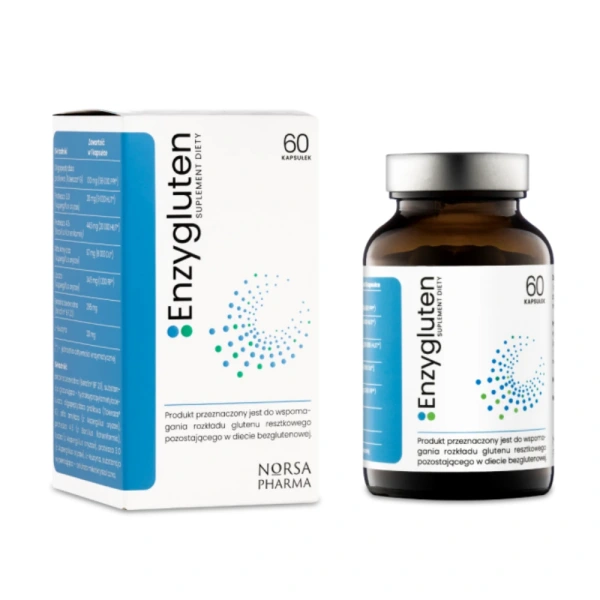- For the home
Health
- Bones and Joints
- Digestion and Healthy GI
- Essential Oils
- Fish Oil / Omega-3
- Healthy Sleep
- Heart and Cardiovascular System
- Immunity
- Liver
- MCT Oil
- Men
- Mind and Focus
- Minerals
- Pet Supplements
- Pro-Health Supplements
- Probiotics
- Senior
- Superfoods
- Urinary Tract
- Vitamins
- Vitamins for hair
- Vitamins for nails
- Vitamins for the skin
- Weight Management
- Woman
Healthy Diet
Herbs
Mother and Baby
Sport
Your Goal
Pet Supplements
Cosmetics
- Cosmetics for children
- Men's Cosmetics
- Unisex Cosmetics
- Women's Cosmetics
- Dezodoranty i perfumy
- Higiena jamy ustnej
- Kosmetyki akcesoria
- Kosmetyki dla dzieci2
- Kosmetyki do ciała
- Kosmetyki do higieny intymnej
- Kosmetyki do opalania
- Kosmetyki do pielęgnacji ust
- Kosmetyki do twarzy
- Kosmetyki do włosów
- Papier toaletowy / chusteczki
NORSA PHARMA Enzygluten (digestive enzymes, gluten breakdown) 60 capsules
Available: 11 szt.
27,53 €
Price per portion: 0,46 €Available: 11 szt.
After purchase you will receive 113 pts
Product Details
- Description
- Dosage
- Ingredients Table
- About the brand
- Nutritional information
- Reviews (0)
- Articles
The product is intended to support the breakdown of residual gluten remaining in a gluten-free diet.
Enzygluten – why is it worth it?
Enzygluten is a carefully selected composition of five digestive enzymes: patented prolyl oligopeptidase (Tolerase®G), amylase, protease 3.0, protease 4.5 and lipase - created to support the digestive tract in the digestion of proteins, carbohydrates and fats.
Enzygluten is an innovative complex of digestive enzymes containing as the main ingredient the patented prolyl oligopeptidase Toleraza®G, which works by breaking down residual gluten remaining in a gluten-free diet. Even with a gluten-free diet, there is a risk of unintentional gluten consumption. That is why the Tolerase®G enzyme was developed.
The product is gluten-free, lactose-free and dairy-free.
Why can gluten be hard to digest?
Gluten protein contains many proline amino acids, which require an advanced digestion process.
Poorly digested gluten fragments may cause adverse reactions in some people.
Tolerase®G degrades epitopes - fragments of gluten antigens - in vitro - more effectively. 1
Enzygluten has been additionally enriched with digestive enzymes that break down macronutrients such as carbohydrates, proteins and fats.
The most important advantages of Enzygluten:
- A comprehensive combination of five digestive enzymes that support the digestive tract in the digestion of proteins, carbohydrates and fats.
- It contains a patented form of the enzyme prolyl oligopeptidase Toleraza®G, which works by breaking down residual gluten remaining in a gluten-free diet.
- Toleraza®G significantly reduces exposure to gluten in the stomach and duodenum.2
- Prolyl oligopeptidase (Tolerase®G) is resistant to low pH and digestion by pepsin. 3
The Enzygluten product includes:
Digestive enzymes
Substances that enable the proper functioning of digestive processes in the body. These are high-molecular proteins responsible for the breakdown of complex compounds into simpler forms. They are secreted naturally in the digestive system by the digestive glands, and although each organ is responsible for a different enzyme, the individual compounds complement each other, so it is important that the body does not lack any of them. Enzymes occur in the body in optimal amounts to perform functions necessary for life and health.4
Prolyl oligopeptidase (Tolerase® G)
Toleraza®G is a patented, innovative and unique proline-specific digestive enzyme designed to support the breakdown of residual gluten remaining in a gluten-free diet.
The enzyme is intended for people sensitive to gluten who, following the rules of a gluten-free diet, are exposed to the consumption of residual gluten hidden in many food products.
Protease 3.0 and 4.5
Proteases, proteinases or peptidases, are the largest family of proteolytic enzymes whose primary function is to split proteins into smaller fragments. Due to their structural and functional diversity, these enzymes perform many functions, including intracellular protein formation or recycling, nutrient digestion, and formation of the immune system cascade.5
Alpha Amylase
Amylase, present in human saliva, was one of the first enzymes known. Amylase takes part in catalyzing polysaccharides - it determines the breakdown of starch and glycogen into simpler sugars. As a result of the action of the enzyme in question on starch, it is gradually hydrolyzed and transformed into dextrins. Ultimately, starch breaks down into smaller maltose molecules, which it is made of. The process of starch digestion begins in the mouth, where alpha-amylase present in saliva begins to break down long starch chains into shorter fragments. This enzyme is naturally produced by the human pancreas, salivary glands and small intestine, as well as by various microorganisms such as bacteria, yeast and fungi.6
Lipase
Lipase is a digestive enzyme that breaks down dietary fats and works by cutting off long-chain fatty acids connected to the glycerol backbone, which includes the triglyceride lipid structure. Removing fatty acids from glycerol allows for better conversion of fatty acid chains into short-chain fatty acids. Lipase is released mainly by the pancreas in the form of pancreatic lipase, but is also found in blood, gastric juices, intestinal juices and adipose tissue. Because lipase is needed for the proper digestion of fats, it affects many body functions, including the absorption of nutrients and the regulation of cholesterol levels.7
Betaine
Betaine contributes to the proper metabolism of homocysteine.8
Betaine is an endogenous amino acid with proven functional properties. It has cardio- and neuroprotective effects and supports nephrological and hepatic protective mechanisms.9
Bibliography:
1. Janssen G., Christis C., Kooy-Winkelaar Y. at al. Ineffective degradation of immunogenic gluten epitopes by currently available digestive enzyme supplements. PLoS One. 2015 Jun 1;10(6):e0128065.
2. König J., Holster S., Bruins M.J. at al. Randomized clinical trial: Effective gluten degradation by Aspergillus niger-derived enzyme in a complex meal setting. Randomized Controlled Trial Sci Rep. 2017 Oct 12;7(1):13100.
3. Stepniak D., Spaenij-Dekking L., Mitea C. at al. Highly efficient gluten degradation with a newly identified prolyl endoprotease: implications for celiac disease. Am J Physiol Gastrointest Liver Physiol 291: G621–G629, 2006.
4. Murray Robert K., Granner Daryl K., Rodwell Victo. HARPER'S BIOCHEMISTRY. PZWL. 2012
5. Shankar, R., Upadhyay, P.K. & Kumar, M. Protease Enzymes: Highlights on Potential of Proteases as Therapeutics Agents. Int J Pept Res Ther 27, 1281–1296 (2021).
6. Peter J. Butterworth, Frederick J. Warren and Peter R. Ellis. Human α-amylase and starch digestion: An interesting marriage. Starch/Sta ̈rke2011,63, 395–405.
7. Okada R, Okada A, Okada T, Okada T, Hamajima N. Elevated serum lipase levels in patients with dyspepsia of unknown cause in general practice. MedPrinc Pract. 2009;18(2):130-6. doi: 10.1159/000189811. Epub 2009 Feb 10. PMID: 19204432.
8. Scientific Opinion on the substance of health claims related to betaine and contribution to normal homocysteine metabolism.. EFSA Journal 2011;9(4):2052.
9.Dobrijević D., Pastor K., Nastić N. at al. Betaine as a Functional Ingredient: Metabolism, Health-Promoting Attributes, Food Sources, Applications and Analysis Methods. Molecules. 2023 Jun; 28(12): 4824.
Dosage
Serving Size: 1 capsule
Servings per Container: 60
Form: capsules
Other ingredients
Aspergillus oryzae), protease 4.5 (from Bacillus licheniformis), lipase (from Aspergillus oryzae), protease 3.0 (Aspergillus oryzae), L-leucine, bulking agent - microcrystalline cellulose.
Norsa Pharma manufacturer specializes in the production and distribution of dietary and medical supplements and in particular dedicated products for people with rare, metabolic and elimination diets. All Norsa Pharma products are developed with the utmost precision and based on the latest scientific research.
It cannot be used as a replacement or substitute for a varied diet.
People taking medications, pregnant and breastfeeding women and people under 18 years of age should consult a doctor before using the product.
The product is intended to support the breakdown of residual gluten remaining in a gluten-free diet and is not intended to replace a gluten-free diet or to prevent or treat celiac disease.
Do not exceed the recommended daily intake.
Keep out of the reach of children.
Best before end: date on the packaging.
Descriptions are the property of the www.mass-zone.eu store. Copying and distributing descriptions is prohibited!
In accordance with the Act of February 4, 1994 on copyright and related rights (Journal of Laws of 2006, No. 90, item 631, as amended)
Manufacturer: Norsa Pharma Sp. z o. o., ul. Prof. M. Życiekowskiego 14, 31-864 Kraków
No one has written a review for this product yet. Be the first to write a review.

























